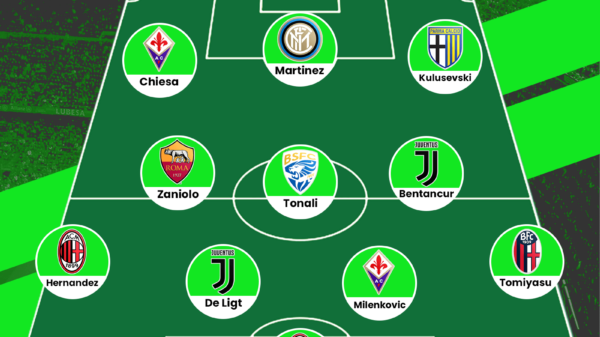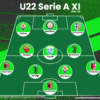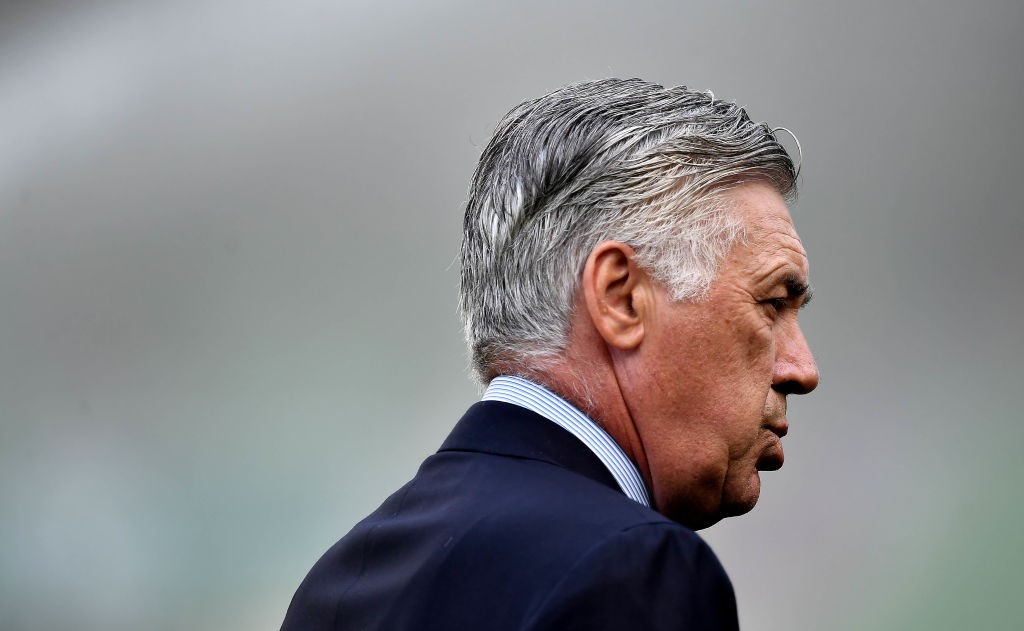Saiguhan Elancheran writes a detailed tactical analysis about the Serie A match that ended Juventus 1-0 Roma.
After successfully seeing out Milan in Rome, Luciano Spalletti took his men to the home of defending champions. The two sides met in the top of the table clash which was expected to be the biggest game of the season so far. As Juventus looked to extend their lead at the top of the table, Roma wanted to close in on the deficit. Along with the three points, Juventus wanted the win badly since it would mark their 25th consecutive league win at home, a record which is already being held by them.
Line Ups:
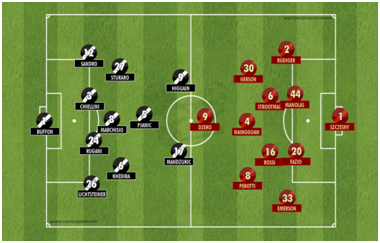
Juventus(4-3-1-2): Buffon // Lichtsteiner(Barzagli 68’) – Rugani – Chiellini – Sandro // Khedira – Marchisio – Sturaro // Pjanic(Cuadrado 51’) // Mandzukic – Higuain(Dybala 82’)
Roma(4-2-3-1): Szczesny // Rudiger – Manolas(Peres 85’) – Fazio – Emerson // Strootman – Rossi(El Shaarawy 72’) // Gerson(Salah 46’) – Nainggolan – Perotti // Dzeko
Having blanked out AC Milan at home, Spalletti just made one change to the side which won 1-0 against Milan. He brought on Gerson for Peres as he was not match fit. On the day, Roma badly missed the services of Salah in the initial stages, who was only fit to start from the bench. On the other hand, Allegri fielded a similar side, with Pjanic being just the only change from the last game.
Juventus played a 4-3-1-2 which later saw transitions to 4-3-3 and 3-5-2 with the substitutions of Cuadrado and Barzagli. Juventus, who are widely known for playing 3 at the back, have preferred the 4-4-2 this season on a regular basis. Meanwhile, Spalletti fielded his side in their standard 4-2-3-1.
Juventus’ approach
Juventus have been seeing experiments being carried out in their team such as the 4-3-3 and the 4-4-2 diamond in this season. During the initial stages of the game Juventus played in a 4-4-2 diamond with Pjanic playing the no.10 role and Marchisio dropping deep. This deployment of diamond in the midfield helped Juventus gain control in the centre and contained attacks through the middle in most occasions.
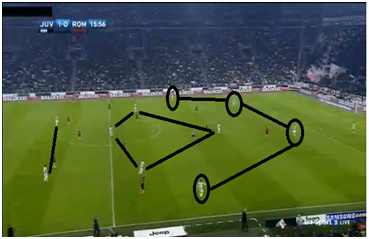
From the above image, we can infer the structure that Juventus took to start the attack when the ball was with them. The two centre backs split wide which would allow Marchisio to drop deep and the two full backs fanned out to help in attack. This 4-4-2 d/3-5-2 variant helped the team to control the game from the centre.
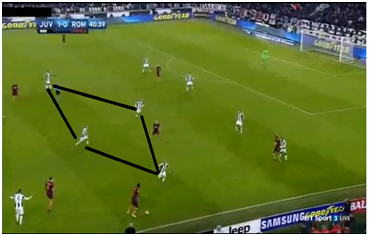
Often during the defensive phases of the game, Juventus maintained their diamond shape as they aimed to nullify Roma’s build-up through the middle. This fine tactic was mainly used to make Roma’s main man Nainggolan ineffective. He was denied the space to run at the defense and hence he failed to provide threatening balls to their target man Dzeko.
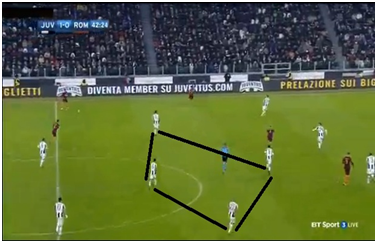
In the above two images, we can identify the shape taken up by the Juventus midfield 4 when the possession is with Roma. This helped to reduce the pockets of space that could be taken up by the Roma players in the middle.
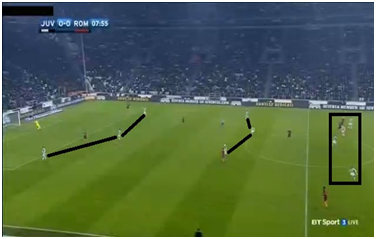
The above image shows the high press posed by Juventus when the ball is being played by Szczesny. Their high press meant that the keeper had to play the long balls to reach out to the other half as the defenders were under the pressure from the Juventus forwards. In this instance, we can also infer that Juventus took a 4-3-3 shape. This allowed to create 3v2 situations at the back as the two Roma FBs fanned out. This gave them the numerical superiority from the starting position in the attacking third.
Consider the below instance, the turnover of a Roma attack has exposed the back very badly. The 2v2 situation in the centre of the final third gives Juve the positional superiority. If the ball carrier from the right wing plays an interesting ball, this would be a great goal scoring opportunity for Juventus. In most occasions of the first half, Roma was caught napping when they lost the ball in the centre as Juventus were very fast in breaks and counters. This was because of the high positioning Juve maintained by which they found themselves in advantageous situations.
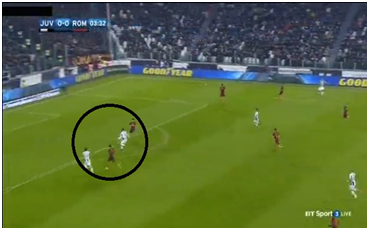
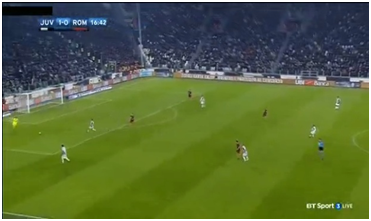
The above instance shows the high offensive line ployed by the Juve players as they always built up pressure on the keeper and made him to play the long balls which created 50/50 situation to retain the possession of the ball back at the middle of the field.
After having gained the lead through a brilliant goal scored by Higuain, Juventus tried to aim for more. They played down the left side as Alex Sandro proved to be the outlet in most of their breaks. Rudiger often tended to move up the field, which left space to be occupied in left flank. Most of the Juventus attacks came through that flank when Sandro linked up with Sturaro. He topped most number of touches list for Juventus.
Juventus favoured creating goal scoring opportunities from long shot situations and were effective in creating goal scoring situations through individual skills. Higuain’s goal came from once such situation when he scored the only goal of the game.
https://www.youtube.com/watch?v=9hPvDTrraRQ
Here we can identify the mistakes made by the central defenders which lead to this brilliant goal. Two CBs Manolas and Fazio were inclined to the 2nd striker Mandzukic. As he starts to make a run behind, as soon as Higuain gets the ball, both the defenders move back with him. Manolas is the main culprit here. He leaves his position, which creates the space for Higuain to run into and he arrives at the pocket of space brilliantly and puts the ball behind Szczesny in an emphatic fashion.
And one of the things to note was the attacking switch made by Allegri. He brought in Cuadrado to replace Pjanic in the beginning stages of the second half which disturbed the balance of the side in the centre as he inclined to the right hand side. As an effect of this, Roma started to develop possession in the middle of the field in a much easier way. But this gave them an edge in the wings. They were able to negate the attacking threats posed by Roma in the wings, when Cuadrado gave them the needed numerical superiority in the flank.
Introduction of Barzagli for Lichtsteiner after an hour’s mark meant that they changed their shape from 4-3-1-2/4-3-3 to 3-5-2. Barzagli along with Rugani and Chiellini formed the back 3 as Cuadrado and Sandro played as the wingbacks. The below image shows the average shape of Juventus in the secondhalf.
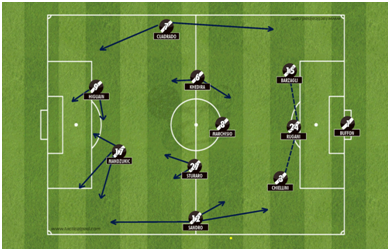
Roma’s approach
For most instances in the game, Roma were compact in the centre. This meant that Juventus had to play their way from the wings. But Juve did well to adapt to this situation in the first half as Lichtsteiner and Sandro provided the width that they required. Roma defended in two banks of four in certain instances when Juventus started to play from the back.

The above instance shows the Roma defence which defended deep when Juventus had possession centrally. Roma defended in two banks of four with Nainggolan providing extra support as he drops back to defend in a 4-4-1-1 shape.
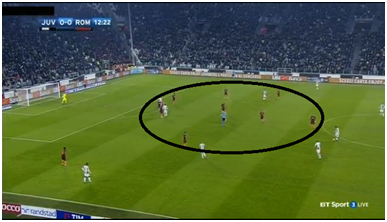
As we can see from the above instance, Roma overloaded the centre. This made sure that Juve couldn’t play from their preferred central build-up play. They were often forced them to play through the wide areas but they shone well as Lichtsteiner and Sandro provided the required width that was necessary.
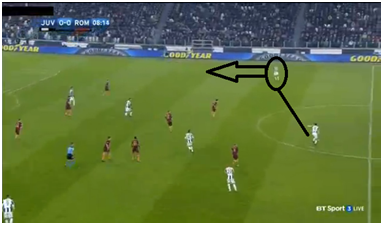
This situation from the first half goes on to prove that fact. Here Roma have overloaded the centre and it would be a tougher option for Marchisio(ball carrier) to pass the ball to Pjanic who is ahead of him. Passing to Pjanic will disrupt their build-up play as 2 or 3 Roma midfielders would immediately press him to get the ball back. Instead he finds a better option in Lichtsteiner who has occupied the pocket of space in the wing which is asked to be exploited. In most occasions of the first half, Roma’s occupancy of spacing in their defensive half was poor and this situation is one such example.
On the other hand in their attacks, Roma tried to play out through the wings. This was evident as Emerson had a game high 86 touches with the right back Rudiger just behind him with 84.
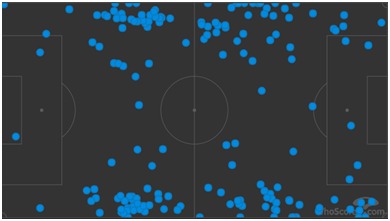
Rudiger and Emerson touch map
via whoscored.com
The above image shows the touches taken up by Emerson and Rudiger in both the flanks. In most occasions their involvement up the field helped in overloading the flanks, thereby creating chances. The below image shows the heat map of the wing backs of both the teams. We can witness the huge difference between them as we can see Roma started to play by the wings as the game progressed. They had better possession in the game to support their cause.
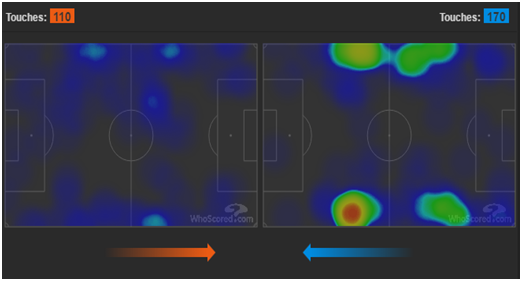
(Heat map: left – Lichtsteiner and Sandro, right – Rudiger and Emerson)
via whoscored.com
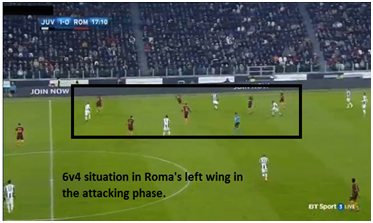
In this image, we can identify the 6v4 overload in favour of Roma. By creating vertical overloads in the wings, especially in the left flank, Roma processed their attacks. And this is evident from the fact that Emerson and Perotti had the most number of exchanges in the game as they had a game high 22 passes between 2 players. As the game progressed and by the introduction of Salah, Roma looked more inventive in their build up but always lacked the cutting edge to score the goal.
Overall, Roma completed 403 passes when compared to Juventus’ 221 and attacking third passes accounted as 138 to Roma and 88 to Juventus. Roma also had better possession with 60-40% in their favour. But credit must be given to Juventus’ defence as they made more number of tackles, blocks and clearances than their counter-part and kept them at bay throughout the match.
Conclusion
The match, which was awaited with great expectation, proved to be a cracker of a game though the score-line reflected otherwise. Questions would be rising in Spalletti’s mind as his side were unable to create clear cut chances though they saw more possession. Juventus extended their winning streak at home and equalled their own record. The win puts them 7 points ahead of Roma at the top, leaving them with a firm hand on the title.
Read all our Tactical Analyses here.























































